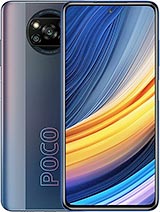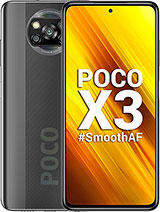Poco X3 Pro full review By GSMArena Official
Hey, what's up guys will here for GSM arena? Last year's Poco x3 NFC was quite a popular value-based mid-ranger and now, a few months later we have a sequel, the Poco x3 pro. Is this one worth upgrading to let's find out in our full review the Poco x3 pro is a mid-range device. That's all about bang, for your buck, just like its predecessor, the Poco x3 and FC, and the locos all the way back to the original f1. The x3 pro is quite similar to the NFC. Both looks wise and feature wise. The design is pretty much identical with the distinctive stripe accents and the large Poco logo.
The back and frame are made of plastic and the finish looks nice. The horizontal camera bump is another unique touch. The x3 pro fits nicely in hand, but it's not the slimmest or most lightweight offer around. Although it's plastic, the phone doesn't feel cheap, and you do get ip53 rated dust and splash resistance. Just like last year, compared to the previous model, the biggest upgrade you'll find on the x3 pro is the chipset.
It's the new flagship grade, snapdragon 860, built on the seven nanometer process. It's actually very similar to the snapdragon 855 plus of 2019's flagships, although it doesn't offer 5g connectivity performance is much better than the snapdragon 732g in the Poco x3 NFC, and actually it blows all the mid-range processors out of the water. CPU and GPU performance are stellar and every bit flagship worthy. This is probably the most powerful phone you'll find in this price range and thanks to an adequate cooling system, you can play games without worrying about overheating and throttling another small upgrade over the x3 NFC is in the storage options. You can have more storage on board, 128 or 256 gigs, and that's still expandable through a hybrid slot.
Pretty much everything else about the x3 pro is the same as last year's model, except for the cameras, but I'll get to that in a bit. For example, you get basically the same screen here. It's a 6.67 inch, IPS LCD with a 1080p resolution and fast 120hz refresh rate. There is gorilla glass, 6, not 5. On top, though, the fast refresh rate adds some extra smoothness when swiping and scrolling- and this is adaptive- it will go down when you're, not interacting with the screen.
There's also a fast 240hz touch sampling rate for extra responsiveness. There is one thing we noticed on the x3 and FC, and you see it again here some ghosting and smearing when you're scrolling fast at the high refresh rate. These little stutters are caused by a lower pixel response time on these screens. Besides that, the display is alright. There's plenty of sharpness at this resolution and blacks are deep enough and colors can be made to be super accurate if you tweak them in settings.
Brightness is decent. It maxes out at around 460 nits with the slider and boosts to 530 nits in auto mode in bright conditions, which, for some reason, is less than on the x3 and FC, and you don't get official hdr10 support on the x3 pro for audio the Poco x3 pro brings back a balanced, stereo, speaker setup. Loudness measures good in our charts and the sound quality, is satisfying with good, mid and high tones, but not much bass, there's also a 3.5 millimeter jack and support for FM radio too. When headphones are plugged in, you can wake up and unlock the x3 pro with the side mounted fingerprint reader power button, it's well-placed and incredibly fast and accurate. The interface of the x3 pro is polo's flavor of mini 12 over android 11.
This is an interface we've seen quite a bit of both this year and last. One of the more interesting features is the ability to split the notification shade into a notification panel and a control panel. You also get an app drawer that will organize your apps into categories on the polo. You can disable the drawer, like you, can on Xiaomi's Redmi phones, and you get an IR blaster, which can send signals for controlling appliances and there's NFC support here too, for contactless payments and connectivity. The Poco x3 pro has a 5 160 William hour battery the same size as the x3 NFC.
It was able to score an awesome, 112 hour endurance rating in our tests, regardless of screen refresh rate. This is a little less than what we got on the x3 NFC, maybe because of the high-powered chipset for charging. You get the same 33 watt adapter in the box that was included last year with it, we were able to charge the x3 pro from zero to 50 percent in half an hour, just a hair less than the previous model. Now finally, onto the cameras, which, rather than an upgrade, are actually a downgrade resolution wise compared to the Poco x3 NFC. The main cam is a 48 megapixel quad Bayer one instead of 64 megapixels and the ultra-wide uses an 8 megapixel sensor instead of last year's 13 megapixels, the 2 megapixel macro cam and depth sensor are unchanged.
However, even though the resolutions are lower, we didn't see a noticeable drop in quality here. The main camera shoots, 12 megapixel photos by default, and these are good for a mid-range camera. There's enough resolve detail, good dynamic range balance, sharpening true to life colors and low noise. You don't see a ton of fine detail here, though, portraits are taken with the help of the 2 megapixel depth sensor. These are quite nice with good, looking detail and colors and proficient subject.
Separation. The 8 megapixel ultrawide camera takes some very decent photos with enough detail, good contrast and ok dynamic range. The distortion correction does a nice job straightening the corners too close up shots taken with the 2 megapixel macro cam are hit or miss since focus is fixed here. The photos are uninspiring too, with poor detail and washed out colors in low light. The main camera shoots acceptable photos which have low noise and a bright enough exposure.
They are lacking in detail and rather soft, though enabling night mode won't drastically improve the quality, but you do get more balanced photos with lower noise, more saturated colors restored highlights and a bit more detail. Nighttime shots from the ultra-wide camera are simply no good. They are dark, smudgy, noisy and lacking in detail. Unlike the Poco x3 NFC, the x3 pro can do night mode on his ultrawide camera, and it gives you pretty usable results. They are still soft, but they are well exposed with good color saturation and decent dynamic range.
Selfies are taken with the 20 megapixel front facing cam, and they have good enough detail. Nice, colors and great contrast. The Poco x3 pro can capture videos with its main camera and up to 4k resolution at 30fps. These have a good amount of detail. Great contrast, accurate, colors and wide enough dynamic range.
Unlike the Poco x3 NFC, you don't have support for 4k on the ultrawide cam 1080p clips are poor in detail, but otherwise the colors contrast and dynamic range are all pretty good. Electronic stabilization can be enabled on either of these cameras, and it works in all available resolutions and frame rates to smooth out wobble and shake in your footage. So that's the Poco x3 pro it brings. The nice features we've already seen on the x3 and FC, like a splash proof, build a large high refresh rate LCD stereo speakers, a large battery and pretty fast charging. But now, on top of that, you get a flagship level chipset and despite my initial concerns, the camera quality here is pretty comparable too.
If you look at the competition at this price, the only upgrades you could really find are an AMOLED screen or a higher res camera, but neither of these would come together with a flagship chipset. Overall, the Poco x3 pro was a clear upgrade over its predecessor, and it isn't even that much more expensive. It delivers a ton of value and is definitely worth recommending. Thanks for watching guys, stay safe and see you on the next one. You.
Source : GSMArena Official


























